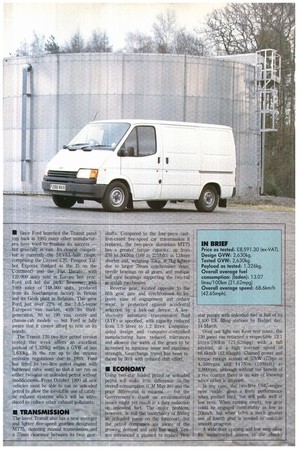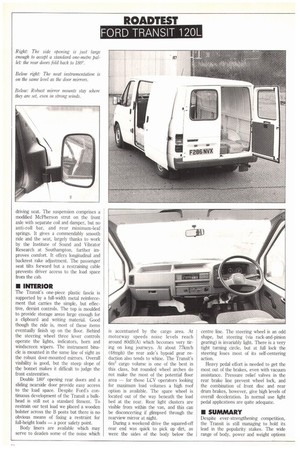• Since Ford launched the Transit panel van back in
Page 57

Page 58

Page 59

If you've noticed an error in this article please click here to report it so we can fix it.
1965 many other manufacturers have tried -to-tnitilate its success — but generally in vain. Its closest competitor is currently the SEVEL-bdilt range, comprising the Citroen C25, Peugeot Talbot Express (badged as the J5 on the Continent) and the Fiat liticato, with 125,000 units sold in Europe last year. Ford still led the pack, however, _with 1988 sales of 148,000 units, produced from its Southampton factory in Britain and its Genk plant in Belgium. This gave Ford just over 22% of the 2-3.5-tonne European van market, with its thirdgeneration, 80 to 190 van, combi and chassis-cab models — but Ford is fully aware that it cannot afford to rest on its laurels.
The Transit 120 two-litre petrol version tested this week offers an excellent payload of 1,326kg within a GVW of just 2,630kg. In the run up to the stricter emission regulations due in 1993, Ford has fitted its two-litre petrol engine with hardened valve seats so that it can run on either two-star or unleaded petrol without modifications. From October 1990 all new vehicles must be able to run on unleaded petrol to allow the inevitable use of catalytic exhaust systems which will be introduced to reduce other exhaust pollutants.
111 TRANSMISSION
The latest Transit also has a new stronger and lighter five-speed gearbox designated M175, denoting manual transmission and a 75mm clearance between its twin gear . .
shafts.. Compared to the four-piece castiron-cased five-speed car transmission it replaces,_ the two-piece aluminium MT75 has a greater torque capacity, up from -230 to 300Nn3 (169 to 2211b1t); is 134mm shorter and, weighing 351(g, IA7kge lig,hter due to larger 78mm synchroniser tangs, needle bearings on all gears, and multiple' ball race bearings supporting the two-rail gearshift mechanism.
Reverse gear, located opposite to the fifth gear gate and Synchronised to improve ease of engagement and reduce wear, is protected against accidental selection by a lock-out device. A lowviscosity automatic transmission fluid (ATP') is specified, with capacity reduced from 1.9 litres to 1.2 litres. Computeraided design and computer-controlled manufacturing have reduced tolerances and allowed the width of the gears to be increased to minimise noise and maximise strength. Gearchange travel has been reduced by 30% with reduced shift effort.
III ECONOMY
Using two-star leaded petrol or unleaded petrol will make little difference to the overall consumption (CM May 88) and the price differential is minimal — but the Government's stand on environmental issues might yet result in a duty reduction on unleaded fuel. The major problem, however, is still the uncertainty of finding an unleaded pump on the forecourt, but the petrol companies are aware of the growing demand and only last week Texaco announced it planned to replace two
star pumps with unleaded fuel at half of its 1,400 UK filling stations by Budget day, 14 March.
Over our light van Kent test route, the 120 panel van returned a respectable 13.1 litresi100km (21.62rnpg) with a full payload, at a high average speed of 68.6ktn/h (42.65mph). Claimed power and torque ratings remain at 57k-W (77hp) at 4,500rpm and 147Nin (1081bft) at 2,800rpm, although without the benefit of a rev counter there is no way of knowing when either is attained.
In any case, the two-litre OHC-engine revs readily, gives a lively performance when pushed hard, hut still pulls well at low revs. When running empty, top gear could be engaged comfortably as low as 50km/h, hut when laden a much greater use of fourth gear is needed to maintain smooth progress.
A wide door opening and low step allow for unobstructed access to the chunky driving seat. The suspension comprises a modified McPherson strut on the front axle with separate coil and damper, but no anti-roll bar, and rear minimum-leaf springs. It gives a commendably smooth ride and the seat, largely thanks to work by the Institute of Sound and Vibrator Research at Southampton, further improves comfort. It offers longitudinal and backrest rake adjustment. The passenger seat tilts forward but a restraining cable prevents driver access to the load space from the cab.
• INTERIOR
The Transit's one-piece plastic fascia is supported by a full-width metal reinforcement that carries the simple, but effective, demist controls. The top is moulded to provide storage areas large enough for a clipboard and writing material. Good though the ride is, most of these items eventually finish up on the floor. Behind the steering wheel three lever controls operate the lights, indicators, horn and windscreen wipers. The instrument binacle is mounted in the same line of sight as the robust door-mounted mirrors. Overall visibility is good, but the steep slope of the bonnet makes it difficult to judge the front extremities.
Double 180° opening rear doors and a sliding nearside door provide easy access to the load space. Despite Ford's continuous development of the Transit a bulkhead is still not a standard fitment. To restrain our test load we placed a wooden bolster across the B posts but there is no obvious means of fixing a restraint for full-height loads — a poor safety point Body liners are available which may serve to deaden some of the noise which
is accentuated by the cargo area. At motorway speeds noise levels reach around 80dB(A) which becomes very tiring on long journeys. At about 77km/h (48mph) the rear axle's hypoid gear reduction also tends to whine. The Transit's 6m3 cargo volume is one of the best in this class, but rounded wheel arches do not make the most of the potential floor area — for those LCV operators looking for maximum load volumes a high roof option is available. The spare wheel is located out of the way beneath the load bed at the rear. Rear light clusters are visible from within the van, and this can be disconcerting if glimpsed through the rearview mirror at night.
During a weekend drive the squared-off rear end was quick to pick up dirt, as were the sides of the body below the centre line. The steering wheel is an odd shape, but steering (via rack-and-pinion gearing) is invariably light. There is a very tight turning circle, but at full lock the steering loses most of its self-centering action.
Heavy pedal effort is needed to get the most out of the brakes, even with vacuum assistance. Pressure relief valves in the rear brake line prevent wheel lock, and the combination of front disc and rear drum brakes, however, give high levels of overall deceleration. In normal use light pedal applications are quite adequate.
• SUMMARY
Despite ever-strengthening competition, the Transit is still managing to hold its lead in the popularity stakes. The wide range of body, power and weight options gives it a wide appeal, but Ford still fails to provide a bulkhead or at least a driver cage as standard.
The introduction of a lead-free two-litre petrol unit has not harmed performance or fuel consumption. The 120's new fivespeed gearbox is smooth and light to operate, with no obvious vices. Its higher rating and advanced design should prove reliable, while its light weight adds slightly to the payload.
Outwardly the Transit's overall appearance is pleasing. Inside the driving compartment is comfortable — but noise levels are high for motorway work.
by Bill Brock












































































































